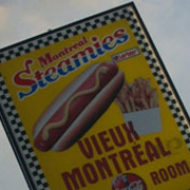I don’t think I’ve written about this, but I am obsessed with large lecture pedagogy. Although a sizeable number of students in my intro class seem to really like it (although liking isn’t the point necessarily) and I get good ratings, I have always been interested in how to be a better teacher. The thing is that a great deal of academic pedagogical theory has been written as if we all teach small classes. The reality, however, is somewhat different. Happily, some people at McGill have realized this and started occasionally having lectures and events that discuss large lecture pedagogy.
Today was one such an event, a lecture by Eric Mazur, a physicist at Harvard, who used to lecture but doesn’t anymore. Instead, he will start a class off with a few brief notes, then post a multiple choice question. Students would be given a clicker and with some software, they could see the aggregate answers for the question. Then, they would have to convince their neighbor of their answer, and the whole class would then answer the question again. Basically, class would be a series of these exercises. Mazur’s theory is that the students who know what they’re doing convince the students who don’t, and his data suggest that students wind up with better comprehension of the material (as opposed to the regurgitation of information they’ve gleaned). I haven’ explained his method well but you can visit his site to learn more.
But there were a couple things I left thinking about (I left “early” — an hour into the presentation, as the room was so stuffy I thought I might faint). First, while this is clearly translatable to the humanities, there are issues about the weight of ideology, and whether rational arguments will win out as often when students are first exposed to the material before they’ve had it explained (if, for instance, they don’t understand the language in “Encoding/Decoding” it’s unlikely that they’ll be able to argue about it. So perhaps some information transmission is good.
The other thing that was striking was Mazur’s finding that retention of material from introductory courses is very low. A year after the class, sometimes only two months later, students who passed an introductory large lecture course in physics will likely “remember nothing but the pain and the grade.” With his method, retention is somewhat higher though not that high. Which leads me to conclude what I’ve always suspected: the very idea of “coverage” is somewhat bogus, because students don’t hold onto the material. It’s better to teach them a way of thinking or simply introduce skepticism, and hope that they retain a few of the ideas you throw at them over the course of the term. That doesn’t mean one should teach narrow courses, only that we shouldn’t try to live up to an impossible idea of comprehensiveness that turns out not to matter.
